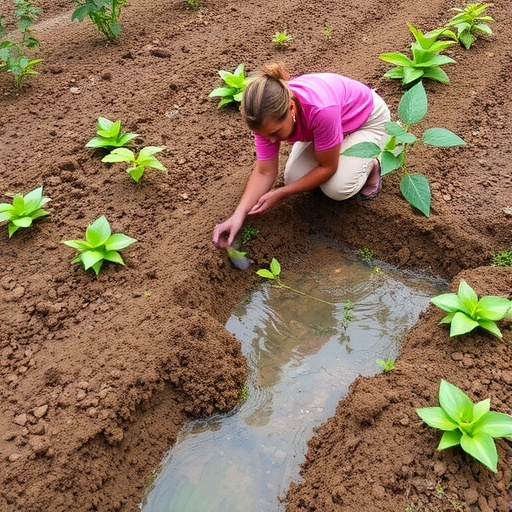In a groundbreaking study conducted in the highlands of Tigray, northern Ethiopia, researchers have unveiled key determinants influencing the adoption of soil and water conservation practices among farmers in rain-fed croplands. The study, conducted by Assefa, Berhe, and Haile, sheds light on the complex interplay of socioeconomic, environmental, and institutional factors that motivate or hinder farmers in implementing sustainable agricultural practices critical for preserving their land and natural resources.
Historical practices in the region have left the landscape vulnerable to soil erosion and water scarcity, creating an urgent need for effective soil and water conservation measures. Farmers in the highlands traditionally relied on conventional farming methods, which have proven insufficient in addressing the challenges posed by climate variability and land degradation. The adoption of modern conservation techniques becomes essential for ensuring the resilience of agricultural systems and the livelihoods of dependent communities.
The research highlights that the major driving forces behind the adoption of conservation practices include farmers’ awareness of the benefits, access to resources, and the availability of technical support. However, the findings indicate that simply providing information is not enough. Farmers’ existing knowledge and past experiences significantly influence their willingness to adopt new techniques. This underscores the importance of tailored educational programs that resonate with local contexts and address farmers’ unique challenges.
Furthermore, the researchers identified socio-economic variables such as income levels, land ownership, and access to credit as critical factors influencing the adoption of conservation practices. Farmers with higher income levels and secure land tenure were found to be more likely to invest in conservation measures. Similarly, access to credit facilities for purchasing necessary materials or hiring labor was another crucial determinant that empowered farmers to take the initiative to conserve their land and water resources.
The impact of local institutions and government policies also played a significant role in determining adoption rates. The study revealed that farmers who received consistent support from agricultural extension services and local community groups were more inclined towards adopting conservation practices. These institutions act as conduits for knowledge dissemination, enabling farmers to understand the relevance and implementation of innovative practices tailored to their environmental conditions.
Despite these positive influences, challenges remain. Many farmers expressed skepticism about the effectiveness of new techniques due to past failures or insufficient demonstration of results. This skepticism necessitates the establishment of trust and confidence through successful case studies and on-the-ground demonstrations that showcase the immediate and long-term benefits of soil and water conservation practices.
The researchers also found that cultural beliefs and norms significantly impacted conservation practice adoption. In some communities, traditional views on land use and stewardship conflicted with modern conservation practices. Understanding these cultural dynamics is essential for formulating strategies that better align agricultural policies with local customs and beliefs, ensuring greater acceptance and participation from the farming communities.
In the context of Tigray’s rain-fed agricultural systems, climate change poses an additional layer of complexity. The shifting climate patterns have resulted in unpredictable rainfall and prolonged dry spells, heightening the urgency for farmers to adapt their practices. By integrating climate-resilient approaches into soil and water conservation strategies, the farmers can fortify their crops against erratic weather, thus securing food production against the backdrop of climatic uncertainties.
Community engagement is also pivotal in fostering a supportive environment for adopting conservation measures. The study emphasizes the importance of collective action, where farmers collaborate to share knowledge, resources, and labor. By working together, communities can enhance their resilience against food insecurity while simultaneously conserving valuable soil and water resources.
The adoption of soil and water conservation practices in Tigray is not merely an agricultural necessity; it is a critical component in the fight against poverty and environmental degradation. As rural communities embrace these strategies, there lies a significant opportunity for improving overall agricultural productivity, ensuring food security, and empowering farmers economically.
In conclusion, the research conducted by Assefa, Berhe, and Haile provides invaluable insights into the determinants shaping the adoption of soil and water conservation practices in Tigray, Ethiopia. By harnessing the power of data and understanding these multifaceted influences, stakeholders can work collaboratively to create targeted interventions that promote sustainable agricultural practices across the region.
Enhancing soil and water conservation adoption is imperative for the future of Ethiopia’s agriculture. As these farming communities navigate environmental, economic, and social challenges, continued research and tailored interventions will be essential in driving change and fostering a sustainable agricultural landscape that benefits both the present and future generations.
The implications of this research extend beyond Tigray, highlighting a broader narrative of sustainable agriculture in the face of climate change. By sharing these insights with the global community, there is a chance to inspire similar initiatives in other regions facing analogous challenges, promoting a unified approach towards sustainable development and environmental stewardship.
As we advance towards a more sustainable future, the integration of soil and water conservation practices in farming communities remains a vital step in ensuring resilience against the challenges posed by climate change and land degradation.
Subject of Research: Determinants of soil and water conservation adoption in rain-fed croplands of the highlands of Tigray, northern Ethiopia.
Article Title: Determinants of soil and water conservation adoption in rain-fed croplands of the highlands of Tigray, northern Ethiopia.
Article References:
Assefa, T., Berhe, M. & Haile, M. Determinants of soil and water conservation adoption in rain-fed croplands of the highlands of Tigray, northern Ethiopia.
Discov Agric 3, 186 (2025). https://doi.org/10.1007/s44279-025-00357-7
Image Credits: AI Generated
DOI: 10.1007/s44279-025-00357-7
Keywords: soil conservation, water conservation, sustainable agriculture, climate change, Ethiopia.





